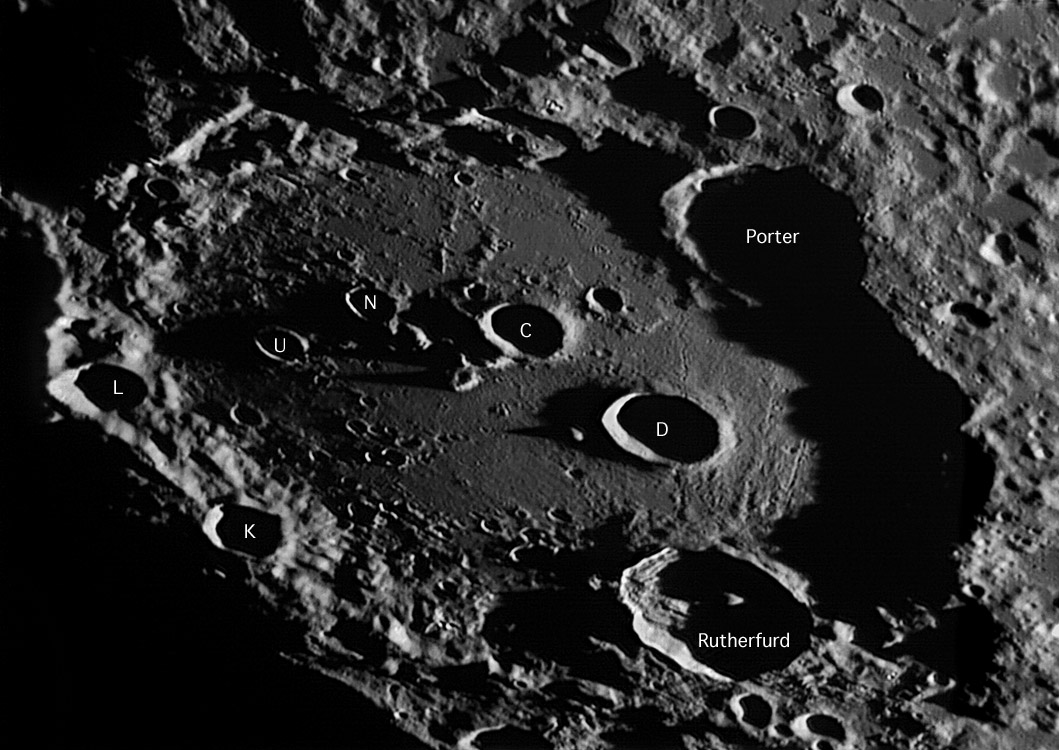LPOD Mar 18, 2008
IRRESISTIBLE

image by François Emond, Chorges, Hautes-Alpes, FRANCE
Images of Clavius are among the most frequent submitted to LPOD, but few are published because they are no better than earlier ones and I have nothing new to say about the crater. François' image has to be published - it gives a new feel for Clavius as a rugged surface with pits, chains, smooth spots and mystery. Three narrow crater chains from Rutherfurd cross nearly to Porter, with a pit on the northern rim of Clavius D suggesting that that crater was there before Rutherfurd formed. Just south of D is a smooth spot at the edge of Rutherfurd's glacis - a patch of impact melt from that crater. Southwest of D is a rimless crater, often a sign of a collapse into a lava tube or other volcanic structure, but this doesn't, in general, look like volcanic terrain. Until we look north of Clavius C and notice the area that is considerably smoother than any other part of Clavius' floor. On the high Sun Clementine view this piece of floor looks no smoother than the center of Clavius' floor south of the central peak. But François' high resolution, grazing illumination image shows how wrong that is. The smooth patch really is free of secondary craters, ejecta rays and other small topography that litter the floor. So we have another highlands smooth plains mystery. No reputable lunar scientist would suggest that this is volcanism, but it also is too far from Rutherfurd to be impact melt, so it must just be a spot that by chance hasn't been modified by other actions. Sometimes its tough trying to be reputable.
Chuck Wood
Technical Details
15 February 2008, ~ 18 h 58 UT. Dobson T400 (~ 16″ Newton) + FFC Barlow lens & webcam cmos PL1-M with red filter. About 220 frames stacked in Registax.
Related Links
Rükl plates 72-73
COMMENTS
To post comments regarding this LPOD, please click here and enter your text in the space below. You will not see the Edit tab unless you register for the wiki. Please do not edit the LPOD itself!
(1) Very nice photo, with great timing. The waxing Moon terminator must have just been hitting Clavius. I wonder what magnification Francois was using?
When I see images that were produced with multiple stacked photos, filters, and image-editing software, I wonder if an observer just looking through a telesccope can see the same thing?
--Bill
(2) In looking at the Moon and thinking about the solar system, I began to wonder if anyone has ever calculated the amount of gas and dust it required to create our solar system?
We see clouds of gas and dust in star-forming regions in Hubble images. As the raw material for stars, these clouds are huge, extending light years in size.
It would be interesting to be able to estimate in terms of light years the size of the gas and dust clouds that would be required to create a solar system like ours. It would make a nice tidbit of information to give to an audience at a public presentation.
--Bill
(3) Bill - The quality of images on LPOD generally can not be equalled by visual observing - smaller details are visible on the stacked and enhanced images such as this. But, BUT, you can still see many fascinating things at the eyepiece because the lighting and libration when you observe often will give a slightly different view than you've seen on any image. And when you observe, its your eyeball collecting the photons!
Models of the formation of the solar system often assume that the original total mass was 2 to 10 times the mass of the Sun - in other words, a lot of material was lost during the formation. And that is what we see with the Hubble looking at newly formed stars and their nebulas.
Chuck
(4) Chuck--Thanks for the information. Two to 10 times the mass of the Sun--and before gravitational collapse, all this material was spread out as a giant cloud of dust and gas. It's amazing.
By the way, last night I attended a public lecture at Baldwin-Wallace College in Berea, Ohio. The topic was asteroids that might be a threat to Earth and discussion of a local program to help track them, etc. Afterwards, the college observatory director showed us the Edward P. Burrell Memorial Observatory, which features a 13-inch refractor built by Cleveland's Warner & Swasey Company. It looked like it was built like a battleship. And stepping into the observatory was like stepping back in time because all of the equipment dated back to 1940. The telescope and observatory apparently have not seen a whole lot of use in recent years, but the observatory director hopes to change this by developing a program to observe variable stars. He needs some funding, however--which I guess can be a problem.
--Bill